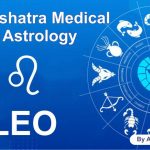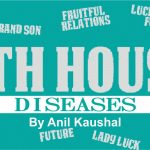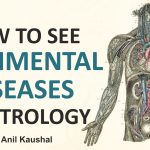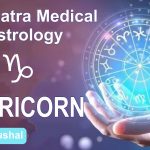
Diseases of Twelfth House
1. Introduction
1.1 The twelfth is the last house of a horoscope when counted from ascendant. Therefore it marks the end or expense of the cycle or the wheel of life. Since lagna represents the life, health, wealth, physical body and vitality etc, the 12 th house represents the destruction or expenditure of these traits. Therefore some astrologers consider it as an alternate house of death along with 8 th house. The association of 12 th house with any house or house lord destroys that house. But any planet when posited in this house unafflicted, it flourishes the Jeeva indication of that house but not the other significations it represents.
Along with 2 nd , this house is considered to be impressions neutral\ and gives results as per the other sign of its lord or planets placed in/ aspecting it.
1.2 As per Phal Deepika, it is known as Leena Sthan (hidden house) and represents sub-conscious mind, sorrows, miseries losses, mental worries, confinement, imprisonment, asylums, loss of children/ spouse, sleep, dreams and fantasies etc. In natural zodiac, this house is represented by watery & mystic Pisces with Jupiter as its lord. It represents feet, left eye and lymphatic system. But Saturn is the primary Karaka of this house, with Mars controlling confinement & accident, Rahu diseases of feet & jail and Jupiter deep knowledge & hope. 12th house represents diseases in the feet, left eye, insomnia, imprisonment/ isolation (being 7th from 6th house), criminals anti-social elements, kidnapping, rape (being 8th from 5th and 5th from 8th house)etc.
2. Diseases of foot
2.1 Diseases of the foot generally are not limited, as they are related to or manifest elsewhere in the body. However, the foot is often the first place some of these diseases or a sign or symptom of others appears.
This is because of the foot distance from the central circulation, the heart and its constant exposure to pressures from the ground and the weight of the body. The foot may look simple but is a complex structure with 26 bones, 33 joints, numerous muscles, nerves and different ligament types. Any part of the foot can be affected. Some foot disorders may present with just a mild ache, but other foot disorders can be very serious and limit ability to walk or bear weight. Most minor cases of foot pain respond to home care treatments except when severe pain is present as it is a disabling condition and usually needs medical attention. Some of the common diseases of foot are given in next sub-Para.
2.2 Fungal/ Bacterial Conditions including athlete foot:
i) Fungal/ Bacterial Conditions including athlete foot, occur because our feet spend a lot of time in shoes- a warm, dark, humid place that is perfect for fungus to grow. Fungal and bacterial conditions can
cause dry skin, redness, and blisters, itching, and peeling. If not treated right away, an infection may be hard to cure. To prevent infections, keep your feet- especially the area between your toes-clean and dry.
ii) Corns, Warts or Spurs are caused by friction and pressure when the bony parts of your feet rub against your shoes. Sometimes wearing shoes that fit better or using special pads solves the problem. A wart is a localized over-growth of skin layer caused by a virus. Spurs are calcium growths that develop on bones of the feet. They are caused by muscle strain in the feet standing for long periods of time, wearing
badly fitting shoes, or being overweight can make spurs worse. Treating them yourself may be harmful, especially if you have diabetes or poor circulation.
iii) Bunions develop when the joints in the big toe no longer fit together as they should and becomes swollen and tender. Bunions tend to run in families. If a bunion is not severe, wearing shoes cut wide at the instep and toes, taping the foot, or wearing pads that cushion the bunion may help the pain. Other treatments include physical therapy and wearing orthotic devices or shoe inserts. Sometimes anti-
inflammatory drug and cortisone injection or surgery is needed to relieve the pressure & pain and repair the toe joint.
iv) Ingrown toe-nails occur when a piece of the nail breaks the skin- which can happen if you don't cut your nails properly. Ingrown toenails are very common in the large toes. In grown toenails can
often be avoided by cutting the toenail straight across and level with the top of the toe.
v) Hammertoe is caused by a shortening of the tendons that control toe movements. The toe knuckle is usually enlarged, drawing the toe back. Over time, the joint enlarges and stiffens as it rubs against
shoes. Your balance may be affected. Wearing shoes and stockings with plenty of toe room is a treatment for hammertoe. In very serious cases, surgery may be needed.
vi) Diabetic Foot: Not all people with diabetes develop foot problems. But people with diabetes are more prone to infection. They can also develop neuropathy (damaged nerves) peripheral vascular disease
(blocked arteries) of the legs and either can lead to foot ulceration. Infection and foot ulceration, alone or in combination, often lead to amputation. Neuropathy and peripheral vascular disease can also
cause distressing pain in the lower limbs. Many people with diabetes are at risk of developing foot problems. For people already with infection or ulceration, the important thing is to urgently treat the
infection and heal the ulcer. For people with pain, the important thing is to determine whether it is due to neuropathy or vascular disease because the treatment for them is quite different.
vii) Frost bite: It is the medical condition where localized damage is caused to skin and other tissues due to freezing. Frostbite is most likely to happen in body parts farthest from the heart and those with large exposed areas. Inadequate blood circulation when the ambient temperature is below freezing leads to frostbite. This can be because the body is constricting circulation to extremities on its own to preserve core temperature and fight hypothermia. If this area freezes further, deep frostbite occurs. The muscles, tendons, blood vessels, and nerves all freeze. The skin is hard, feels waxy, and use of the area is lost temporarily, and in severe cases, permanently. The deep frostbite results in areas of purplish blisters which turn black and which are generally blood-filled. Nerve damage in the area can result in a loss of feeling. This extreme frostbite may result in fingers and toes being amputated if the area becomes infected with gangrene. If the frostbite has gone on untreated, they may fall off. The extent of the damage done to the area by the freezing process of the frostbite may take several months to assess, and this often delays surgery to remove the dead tissue.
viii) Plantar fasciitis is a very common cause of heel pain. The thick fibrous bands at the bottom of the heel get inflamed and cause excruciating pain. The pain occurs the moment you step out of bed. After a few hours, the pain does subside but can return after prolonged periods of standing. Plantar fasciitis is most common in runners, obese individuals, women who are pregnant and those who wear shoes with inadequate heel support. The treatment of this agonizing disorder involves pain control, steroid injection, proper foot wear and rest.
ix) Vascular disorders
a) Atherosclerotic restriction to the arterial supply in peripheral artery occlusive disease may result in painful arterial ulcers of the ankle and foot, or give rise of gangrene of the toes and foot. Immobility of
a person may result in prolonged pressure applied to the heels causing pressure sores.
b) Impaired venous drainage from the foot in varicose veins may sequentially result in brown hemosiderin discoloration to the ankle and foot, varicose stasis dermatitis and finally venous ulcers.
c) Astrologically 12th house and sign Pisces and its lord Jupiter represent feet. Rahu and Saturn are karka for diseases of the feet. Any relation of these with other Trika houses/ lords indicates problem in the feet.
3. Gout
3.1 Gout is kind of arthritis. It can cause an attack of sudden burning pain, stiffness, and swelling in a joint, usually a big toe, small joints of feet hands, ankle and knee. These attacks can happen over and
over unless gout is treated. Over time, they can harm joints, tendons, and other tissues. An acute of gout is intensely a disorder caused by precipitation of uric acid in the joint. Generally women are more
prone to gout after menopause.
3.2 Astrologically it is windy (Vata) diseases with Mercury, Venus and Saturn as Karaka. Some of the astrological combinations are:
1. Saturn and Mars in mutual Trikonas or mutual aspect.
2. Saturn in 2nd / 3rd / 8th house aspected by malefics.
3. Sun, Moon, lagna and 12th house are afflicted.
4. Saturn and Jupiter in 1-7 axes.
5. Waning Moon with Saturn in 12 th house.
6. Venus conjuncts with Saturn in Aries or aspected by Mars.
7. Saturn in sign of Jupiter or Jupiter in sign of Saturn aspected by Mars.
8. Sun and Moon are afflicted in a watery sign.
9. Venus in 8 th afflicted by malefics.
4. Left Eye
4.1 Eyes in general have been dealt in 12th house represents left eye and
Moon is the karaka for it, while Sun in 12th eye represents right eye.
The Venus is karaka for vision/ eyesight. Various diseases for left or right eye are common. Saturn, Mars, Rahu and Trika lords on afflicting Moon, Sun and Venus and 12th house/ lord cause eye problems in left eyes.
5. Insomnia
5.1 Insomnia, or sleeplessness, is in sleep disorder in which there is an inability to fall asleep or to stay asleep as long as desired. It is a disorder demonstrated by polysomnography evidence of disturbed
sleep. Insomnia can also be sleep disorder not attributable to medical, psychiatric, or environmental cause. Thus, insomnia can accompany several sleep, medical, and psychiatric disor characterized by a persistent difficulty falling asleep and/ or staying asleep by functional impairment Insomnia can lead to memory problems, depression, irritability and an increased risk of heart disease and automobile related accidents. Insomnia can be grouped in to following four categories:
1. Tension Type: It consists of people who have been under some sort of strain/ anxiety all day long and who go to bed too tightly wound up to find sleep. They may roll and toss and ponder for couple of
hours, before falling into a sleep are often too deeply asleep.
2. Fatigue Type: People of this group are often older folk, who get progressively more tired as the day wears on. By evening they can hardly keep their eyes open and often fall asleep after early dinner.
Then when bed times come, they find they cannot woo sleep and frequently wake too early in the morning.
3. Hurting Type: These are people whose sleep is drive away by various forms of pain or discomfort. This may be indigestion, arthritis, cramp, or other complaints or it may lie in night sweat, hot flushes, coughing, too hot/ cold a bed bedroom or simply an unsuitable matters. Such people may fall into intermittent sleep, but they keep waking all through the night.
4. In & Out Type: These people believe themselves to be worst insomniacs. What actually happens is that they are rapidly going in and out of sleep, although they connect the waking periods as a
continual mental process. They do not register the time they have spent asleep at all. This is a highly neurotic and stressful group who are emotionally over tense and who find life's problems too much.
5.2 Astrologically, 12th house and Pisces is seat of Insomnia. Moon is the primary Karaka, but Lagnesh & Mercury and influence of Trika house/ lords also should be considered. Some of the combinations for insomnia are:
1. Sun and Mars in Lagna and aspected by a malefic.
2. Pisces, 12th house and Moon is afflicted.
3. 12th in Lagna and Moon is afflicted.
4. Sun and Moon in 8th conjunct/ aspected by Mars/ Saturn.
5. Moon in 12th conjunct or aspected by Ketu.
6. 12th lord in lagna or 5th conjunct with malefics.
7. Moon in 12th conjunct with or aspected by malefics.









Your point of view caught my eye and was very interesting. Thanks. I have a question for you.
I don’t think the title of your article matches the content lol. Just kidding, mainly because I had some doubts after reading the article.
I don’t think the title of your article matches the content lol. Just kidding, mainly because I had some doubts after reading the article.
I don’t think the title of your article matches the content lol. Just kidding, mainly because I had some doubts after reading the article.
Vitamin D helps strengthen bones and joints by supporting calcium steadiness and decreasing
irritation. A research printed in Therapeutic Advances in Musculoskeletal Illness (Kathryn R Martin et al.,
2017) found a strong link between vitamin D deficiency and joint ache.
Bee venom has gained consideration for its anti-inflammatory
and joint-supporting effects. It helps restore joint tissue and enhance mobility by influencing the body’s immune response.
Bee venom contains melittin, which has been shown to minimize back inflammation by blocking
inflammatory pathways. Are you wondering if Soothen Ache Relief Cream can scale back joint ache, ease arthritis symptoms, and allow you to move better?
A total of 9 cervical ESI procedures have been performed utilizing a catheter-based method.
Corticosteroids fall along a spectrum from exclusively glucocorticoid effects to exclusively mineralocorticoid effects, and steroid compounds are selected primarily based on their appropriateness for a given remedy.
For instance, though a compound might possess potent antiinflammatory properties,
it may also have mineralocorticoid activity that adversely impacts blood stress.
In one research, Deca Durabolin was given to 18 males experiencing joint
pain. Following therapy, 72% reported a reduction in pain, and 28% required much
less painkiller medicine (3), demonstrating the potent
anti-inflammatory effects of the steroid. In this small
case series, no procedural problems were observed, supporting the potential utility of
this method in appropriately selected sufferers. While each techniques
have clinical utility, each comes with its personal limitations.
Thus, it have to be processed by the liver
before changing into lively, inflicting further workload for the organ. Erythrocytosis
will occur with all anabolic steroids, however most may even trigger dramatic weight gain and water retention. Nonetheless, in our experience, somebody frequently eating in a 500-calorie deficit and taking a reasonable dosage of Winstrol (20
mg/day) can expect to burn approximately 5-6% body fats in an 8-week cycle.
Deca Durabolin and testosterone what are the short term effects of steroids (Rodrick) two of the most cardiovascular-friendly
steroids available. Testosterone enhances Deca
Durabolin because of testosterone’s androgenic nature, which reduces the sexual unwanted facet effects of Deca Durabolin.
This is as a end result of even when they stop taking Deca Durabolin, it’ll stay of their system for up
to 12 days. Endogenous testosterone levels will decrease dramatically, requiring a PCT.
Some customers can experience hair thinning, recession, or loss on the
scalp because of testosterone-raising DHT (dihydrotestosterone).
This cycle is much less hair-friendly in our experience compared to the Deca Durabolin/Dianabol stack.
Thus, oral Winstrol is more simply broken down and cleared by the physique;
thus, more regular dosing is needed to maintain peak serum testosterone.
This cardiovascular side impact is particularly notable on Winstrol as a end result of it being an oral steroid and thus hepatic lipase
being stimulated in the liver, which can cause further reductions in HDL ldl cholesterol.
With Winstrol depleting intracellular water ranges, we find it isn’t essentially
the most potent of AAS at enhancing power. This is as a outcome of of
decreased ranges of adenosine triphosphate production contained in the muscle cells,
a protein molecule essential for power. Winstrol significantly will increase strength due to
larger levels of protein synthesis and nitrogen retention inside the muscle cells.
Winstrol thus permits athletes to stay gentle and powerful as a result of simultaneous muscle constructing, fat loss, and water
loss. Based Mostly on our lab outcomes, Winstrol is amongst the finest steroids
for muscular endurance because of the stimulation of
new red blood cells (erythrocytosis).
As AAS use is comparatively unusual among females, ladies
who do use these substances might characterize an atypical subpopulation with a larger burden of psychological
distress relative to males who use AAS, as has been previously suggested [18, 25, 40].
Our findings are consistent with earlier research which
has indicated increased aggression and labile temper amongst
girls who use AAS [37, 38]. Additionally, in a qualitative study ladies described
feeling “grumpier” and finding that they lacked endurance whereas on cycle, in addition to
elevated anxiousness [49].
Humira is a tumor necrosis factor blocker that’s used to treat many inflammatory conditions such …
Contributed to knowledge collection and evaluation and modifying of the manuscript.
All authors contributed to the conceptualization and planning of the manuscript.
Deca Durabolin is predominantly used for bulking purposes; however,
because of it solely building reasonable quantities of lean muscle (by
bodybuilding standards), it’s often cycled with different,
more potent AAS. Deca Durabolin is a slow-acting steroid containing lengthy esters; therefore, cycles usually last as long as
12 weeks. The patient backgrounds, together with scientific and endoscopic exercise, weren’t significantly completely different
between the VDZ + rPSL and non-VDZ + rPSL teams (Table 1).
Your article helped me a lot, is there any more related content? Thanks!
I don’t think the title of your article matches the content lol. Just kidding, mainly because I had some doubts after reading the article.
get cheap clomid for sale buy cheap clomid clomid or nolvadex for pct where to get cheap clomiphene no prescription how to get generic clomid pill clomid risks where buy clomid without prescription
Injectable choices, like Trenbolone or Deca-Durabolin,
supply powerful, long-lasting outcomes and are good for building solid, high quality muscle
over time. Winstrol also boosts energy and endurance, which is a major win throughout slicing phases when vitality levels can dip.
The primary benefit of Dianabol lies in its ability to dramatically enhance
protein synthesis, which is crucial for building muscle.
Some users discover it increases their appetite, whereas others find Anadrol does kill the appetite.
Commonly used for muscle growth, Nandrolone is commonly the go-to for feminine athletes and
sportswomen. Though, if you’re slightly squeamish this
will not be your first steroid of choice as it’s injected instantly into
the muscle for quicker muscle development. When it comes to taking steroids, there is no one measurement matches all resolution. Other components come into play
which might alter the user’s expertise, including genetics, age, intercourse and environmental elements, too.
Weight achieve will not be dramatic on trenbolone (despite its exceptional
ability to add muscle tissue) due to its simultaneous fat-burning results.
Trenbolone may trigger a lack of water weight on-cycle by way
of inhibition of the aromatase enzyme. Testosterone causes aromatization;
thus, excessive levels of testosterone are converted into estrogen. This can lead to water retention, causing a bloated or easy
look to the muscular tissues. Consequently, we frequently
see oral steroids having a harmful effect on liver and coronary heart well being.
This is due to a stimulating impact on hepatic lipase within the liver,
inflicting substantial alterations in levels of cholesterol.
Testosterone Enanthate speeds this repair up noticeably
(but you’ll want to wait a quantity of weeks to see this
benefit with Testosterone Enanthate). These who aren’t skilled
steroid users may have outstanding positive aspects in regard to muscle mass.
Whereas experienced steroid customers might be less delicate by way of
years of cycles and will experience milder gains.
Trenbolone is actually an injectable steroid used by bodybuilders to gain giant quantities of lean muscle and strength while enhancing
fats loss (1). Excessive muscle and power gains, mixed with rapid fat loss,
could be anticipated with this cycle. This stack isn’t appropriate for novices and
may only be taken as quickly as you might be snug with the
consequences of a trenbolone-only cycle.
The cycle length should resemble a regular steroid cycle at eight to 12 weeks.
In this case, you’ve a quantity of AAS providing the real anabolic steroids online activity,
with testosterone enanthate used just for TRT. 250mg is
often sufficient, aside from some steroids like Masteron and Equipoise, which
typically need a testosterone base dose of up to 350mg/week because of their anti-estrogenic exercise.
Stacked with mid to high doses of testosterone is the place huge power increases will develop, and this may
be a common way of using Deca or NPP. Most Deca users will find
the power features of Deca alone to be more potent than what
you’d get on a mg per mg basis in comparability with testosterone.
These are steroids, which are synthetic derivatives of testosterone that give
comparable results to that male hormone.
Like with bulking steroids, there’s quite lots of
each oral and injectable steroids to select from, every with
its personal set of benefits for these in search of the best slicing steroid routine.
For anyone new to bodybuilding and trying to make critical positive aspects in muscle mass, Dianabol is a superb choice.
Its ability to ship fast muscle progress, improve energy, and enhance protein synthesis makes it a popular choice
amongst beginners. Anabolic steroids are derivatives of testosterone, the male intercourse hormone answerable for male characteristics during puberty, corresponding to a deeper voice, body and facial
hair, and muscle energy. When anabolic steroids are used with no prescription, to
increase muscle mass, decrease fats, and enhance performance they’ll
trigger a number of undesirable side effects. Greatest newbie steroid cycles typically include Testosterone Enanthate for its straightforward impact
on testosterone levels and muscle-building capabilities.
A plan that by no means fails is to make use of Dbol for the primary six weeks solely at as
a lot as 35mg day by day (but 25mg is fine, particularly if that
is your first). The entire cycle makes use of
Deca at 300mg weekly and testosterone at 500mg weekly for
the whole 12 weeks. Once More, observe the 1 Vial Testosterone Cycle above and substitute the Check
with Deca. The cycle runs for under eight weeks, sufficient for Deca to work to its
maximum effect. The syringe markings will say “cc,” and your
steroid doses will be measured in ml or milliliters.
This means for each ml you take from the bottle, there might be 200mg of testosterone in it.
This is the place buying quality gear counts because you
don’t need low-quality stuff that’s under-dosed.
With EQ’s lower androgenic rating, ladies will often take around 50mg/week and have
the ability to hold virilizing results at bay, with some recognized to take
up to mg. Nevertheless, this larger dose
can have the effect of halting menstruation. For greatest results, we find that
Anadrole must be combined with different authorized bulking steroids, similar to
Decaduro, Testo-Max, D-Bal, and/or Trenorol. We rated Loopy Bulk as the
best legal steroid retailer (considerably), receiving hundreds of constructive verified customer evaluations (with an average ranking
of 4.4/5).
Deca Durabolin doesn’t just produce impressive
features in mass but also drastically increases intracellular fluid, leading to distinctive muscle
fullness and thickness. We have seen trenbolone cause a hefty rise in blood pressure in almost
all sufferers due to its efficiency and due to its stimulative effects on the
central nervous system (increasing adrenaline production).
In our expertise, testosterone suppression with Dianabol is typically important, with endogenous levels taking a number of months to
revive to normal levels. A PCT, together with a SERM similar to clomiphene, might help shorten this recovery period.
Dianabol is a C-17 alpha-alkylated steroid, and thus liver toxicity
is for certain, basically rising the workload on the
organ.
When on a cycle with nearly any compound, you’ll notice that
your recovery will considerably improve. You will see yourself recovering quicker and needing
much less downtime between sessions27. Anticipate very fast outcomes with this stack due to Anadrol, the fast-acting oral steroid.
Anticipate gains anywhere from 15lbs up to 35lbs on the extreme finish if
you’re not a tough gainer or don’t have a huge variety of cycles underneath your
belt but. Count On superb pumps thanks to the large nitrogen retention enhance with Deca.
If this is considered one of your first cycles, you probably can simply see gains in the 25lb range.
These with extra experience may discover positive aspects slightly extra moderate, but they’ll
still be ultra impressive even in the 10-15lbs vary.
Whereas bulking phases concentrate on size and energy, cutting cycles
are where precision matters most—burning fats while protecting hard-earned lean muscle.
This is where Clenbutrol, Loopy Bulk’s hottest chopping agent,
steps in. Designed to imitate the effects of Clenbuterol—once used
as a bronchodilator and misused for fat loss—Clenbutrol provides a protected, legal, and stimulant-free various for critical physique refinement.
In a market saturated with muscle-building merchandise and performance supplements,
Crazy Bulk has emerged because the leading authorized steroid firm trusted by thousands
of health enthusiasts worldwide. Built on a foundation of transparency, scientific
formulation, and performance-focused stacking techniques,
Loopy Bulk continues to set itself aside as the go-to provider of legal
steroid alternate options in 2025. This powerhouse supplement mimics the muscle-building
effects of Dianabol with out the nasty side effects or legal dangers.
The secret lies in its potent blend of natural elements that work synergistically to spice
up protein synthesis, improve nitrogen retention, and elevate testosterone ranges – the holy
trinity of muscle development.
Bear In Mind, as with every highly effective muscle building supplement, Testol a hundred and forty works best when combined
with a strong coaching program and proper diet. It’s not a
magic pill, but quite a software to amplify your efforts in the
health club. Used responsibly, Testol one hundred forty may help you achieve the kind of transformation that was once
potential only with hardcore steroid cycles.
Sustanon is apparent testosterone, so you get all the
advantages of that hormone as you’ll with a single-ester product.
This means muscle progress, maintaining lean muscle and increased strength, and psychological
advantages like enhanced clarity and focus.
Sustanon 250 promotes protein synthesis and nitrogen retention, growing Insulin-Like Development Factor-1 to boost anabolism whereas decreasing destructive stress hormones.
CrazyBulk not solely offers legal steroid alternatives that align along with your fitness goals, but also ensures a reliable, transparent, and secure purchasing course of.
Whether you’re shopping for a single product or a sophisticated stack, it’s essential
to know how the pricing construction works, what protections are in place, and the place to buy safely.
I’ve seen athletes rework their physiques with Tren Max, attaining that dry, shredded look while nonetheless
packing on measurement. IGF-1 is naturally increased each time
you exercise without the use of steroids, but Deca supercharges this course of beyond what the physique is capable of alone.
IGF-1 is a development hormone, so it is liable for the muscle’s
development at its most simple. It’s an important hormone for increasing lean mass,
enhancing protein synthesis, burning fats, and repairing and recovering muscle tissue.
Deca can even improve collagen synthesis, which provides this steroid for its well-known benefits on joints and connective tissue.
Many girls can run EQ for long cycles at low doses with minimal
to no side effects. I’ve even heard of some
females working it year-round at very low doses of
underneath 50mg per week. “A tiny bit more body hair after a couple of years”
is a notable comment from a girl utilizing EQ year-round in a cruising and blasting protocol.
Some males completely use EQ for performance positive aspects and not essentially for bulking or even chopping.
Needless to say, EQ is a legendary AAS for increasing stamina and endurance.
Because it’s nearly all the time stacked with different AAS influencing your results.
Anabolic steroids are synthetic variations of the hormone testosterone.
They are designed to mimic the consequences of pure testosterone in the body, notably its anabolic extreme, Venetta,
(muscle-building) properties. Anabolic steroids work by growing protein synthesis within cells,
which leads to enhanced muscle progress, improved energy, and accelerated recovery from exercise.
On the other hand, SARMs are selective androgen receptor
modulators which are stated to duplicate the consequences of anabolic steroids.
More posts like this would force the blogosphere more useful.
More posts like this would make the blogosphere more useful.
zithromax order online – generic flagyl buy flagyl 400mg generic
70918248
References:
what steroid burns Fat, https://aliah.dawah.in/question/What-is-a-programmers-life-like/,
rybelsus 14 mg cheap – buy periactin without a prescription purchase cyproheptadine online
70918248
References:
None (Hroom.Co.Uk)
generic domperidone 10mg – buy motilium 10mg online order flexeril generic
buy inderal 20mg sale – buy plavix pills for sale buy methotrexate online
cheap amoxil generic – buy diovan 160mg order generic ipratropium 100mcg
azithromycin 250mg tablet – brand tindamax 500mg order nebivolol 5mg
buy augmentin 1000mg for sale – atbio info ampicillin online buy
nexium 40mg pill – https://anexamate.com/ buy nexium 40mg sale
warfarin 5mg oral – blood thinner buy cozaar generic
buy mobic generic – https://moboxsin.com/ order mobic 15mg without prescription
prednisone 40mg over the counter – aprep lson prednisone 10mg cheap
medications for ed – cheap erectile dysfunction buying ed pills online
amoxicillin tablet – comba moxi buy amoxicillin cheap
cost diflucan 100mg – on this site forcan uk
how to buy escitalopram – https://escitapro.com/# lexapro 10mg pills
order cenforce for sale – https://cenforcers.com/ order cenforce 50mg for sale
buy cialis online no prescription – does cialis lowers blood pressure order cialis no prescription